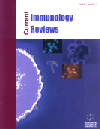- Home
- A-Z Publications
- Current Immunology Reviews (Discontinued)
- Previous Issues
- Volume 1, Issue 2, 2005
Current Immunology Reviews (Discontinued) - Volume 1, Issue 2, 2005
Volume 1, Issue 2, 2005
-
-
New Aspects of the Role of LFA-1 in Bacterial Infection
More LessLeukocyte function-associated antigen (LFA)-1 (CD11a/CD18) is considered to play a pivotal role in a broad range of cellular events, ranging from firm adhesion of leukocytes to endothelial cells initiating leukocyte transmigration and extravasation to functional activation of various inflammatory cells promoting type 1-immune responses. Yet, recent studies argue against the role of LFA-1 in these inflammatory respo Read More
-
-
-
Mycobacterium tuberculosis and Dendritic Cells: Who's Manipulating Whom?
More LessAuthors: Ludovic Tailleux, Brigitte Gicquel and Olivier NeyrollesTuberculosis (TB) remains one of the most common potentially fatal infectious diseases worldwide. The need for more effective vaccines will benefit from a better understanding of the complex interactions between Mycobacterium tuberculosis and the human immune system. Among antigen-presenting cells, dendritic cells (DCs) are thought to play a central role in immunity against this bacillus, and numerous reports published Read More
-
-
-
New Generation of Immune Modulators Based on Toll-Like Receptor Signaling
More LessAuthors: Faiza Rharbaoui and Carlos A. GuzmanThe innate immune system promotes and guides adaptive immune responses, particularly against intracellular pathogens, through the recognition of pathogen-associated molecular patterns. An improved understanding of the functional properties of this system, its key ligand-receptor systems and their signaling cascades is a pre-requisite for the development of new strategies for immune intervention. Toll-like receptors (TLRs) r Read More
-
-
-
The Molecular Basis of Th2 Development
More LessBy Min Li-WeberIn response to antigen stimulation, naïve T helper (Th) cells develop into highly polarized effector cells that mediate effective immune responses. Th1 cells promote cellular immunity and are characterized by the production of IFN-γ, whereas Th2 cells are important for humoral immunity and produce IL-4, IL-5, and IL- 13. Both Th1- and Th2-mediated immunities are important for the host's defense against infections. However, Read More
-
-
-
Interleukin-12: An Update on its Immunological Activities, Signaling and Regulation of Gene Expression
More LessAuthors: Jianguo Liu, Shanjin Cao, Sunjung Kim, Elaine Y. Chung, Yoichiro Homma, Xiuqin Guan, Violeta Jimenez and Xiaojing MaInterleukin-12 (IL-12) is a heterodimeric cytokine composed of the p35 and p40 subunits. It is produced by antigen-presenting cells and plays a critical role in host defense against intracellular microbial infection and control of malignancy via its ability to stimulate both innate and adaptive immune effector cells. The potency of IL-12 renders itself to stringent regulation of the timing, locality and magnitude of its production d Read More
-
-
-
Immunotherapy for Alzheimer's Disease: Potential Problems and Possible Solutions
More LessAuthors: David H. Cribbs and Michael G. AgadjanyanThe primary component of senile plaques is the β-amyloid peptide (Aβ), and the amyloid cascade hypothesis proposes that this putative neuropathological peptide is a causal factor in the onset and progression of Alzheimer's disease (AD). Many of the strategies currently being investigated as therapies for AD are aimed at reducing the level of Aβ in the brain or blocking the assembly of the peptide into potentiall Read More
-
-
-
Pathogen Interactions with DC-SIGN Modulate Immune Responses: A Toll Tale?
More LessAuthors: Lot d. Witte, Yvette van Kooyk and Teunis B.H. GeijtenbeekDendritic cells (DCs) are essential to the induction of pathogen-specific immune responses. The initial interaction between DC and pathogen and the activation of different pattern recognition receptors, such as C-type lectins and Toll-like receptors, dictates the immune response. A prototypic C-type lectin DC-SIGN interacts with a variety of pathogens, including HIV-1, Hepatitis C virus, Mycobacterium tuberculosis and Helicobacte Read More
-
-
-
New Insights on the Allergy-Linked β Subunit of the High Affinity IgE Receptor: Mechanisms and Clinical Implications
More LessAuthors: Yasuko Furumoto, Mikako Takasugi and Juan RiveraThe high affinity IgE Fc receptor (FcεRI) on mast cells and basophils has a central role in allergy and asthma. The β subunit of this multimeric receptor is a membrane tetra-spanning protein that encodes a nonconventional immunoreceptor tyrosine-based activation motif (ITAM) that imparts it signaling competence. This subunit was shown to amplify FcεRI signaling causing increased cellular responses such as degran Read More
-
-
-
CD24 in Experimental Autoimmune Encephalomyelitis and Multiple Sclerosis: Targeting Redundancy for Immunotherapy?
More LessAuthors: Yang Liu, Xue-Feng Bai, Qunmin Zhou, Ou Li and Pan ZhengAn interesting puzzle in the field of T cell costimulation is the apparent redundancy of costimulatory molecules for T cell activation. Our analysis over the last decade of CD24 may shed some light on the issue. CD24 was first identified as a costimulatory molecule for T cell activation over 12 years ago when we used activated B cells as antigen-presenting cells. Subsequent studies using mice with a targeted mutation of CD24 r Read More
-
-
-
Rapid Response Research - SARS Coronavirus Vaccines and Application of Processes to Other Emerging Infectious Diseases
More LessAuthors: Raymond H. See, Rachel L. Roper, Robert C. Brunham and B. B. FinlayThe near pandemic caused by the severe acute respiratory syndrome (SARS) emphasized that new and emerging infectious diseases not only continue to plague the world but also how the scientific community can unite to rapidly identify the causative agent and develop strategies such as vaccines to control its spread. The availability of the SARS coronavirus (SARS-CoV) genome sequence paved the way for the identificatio Read More
-
-
-
Signaling by ITIM-Bearing Receptors
More LessAuthors: Annelies Verbrugge and Linde MeyaardIn order to respond adequately to pathogens without damaging the host, a balance between activating and inhibitory signals is required in the immune system. Over the past years a large number of inhibitory immune receptors has been identified. Most of these receptors contain one or several Immuno receptor Tyrosine-based Inhibitory Motif (ITIM)s in the intracellular part. These ITIMs recruit SH2 domaincontaining phos Read More
-
Volumes & issues
Most Read This Month
Article
content/journals/cir
Journal
10
5
false
en


